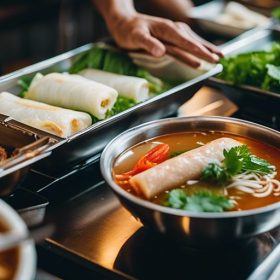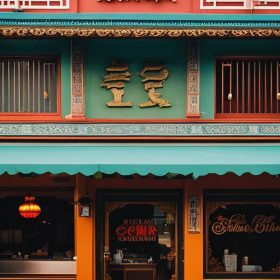Vietnamese cuisine is known for its unique flavors and diverse range of dishes. From the fragrant herbs and spices to the fresh ingredients, Vietnamese food is a culinary delight that has captivated the taste buds of people around the world. Food holds a special place in Vietnamese culture, with meals often being a time for family and friends to come together and share in the joy of eating. In this article, we will explore some of the most fascinating aspects of Vietnamese cuisine, from the history of snake wine to the cultural significance of pho.
The History of Snake Wine in Vietnam
Snake wine, also known as ruou ran or ruou ran ho mang, has a long history in Vietnam. It is believed to have originated in China, where it was used for its medicinal properties. The practice of infusing snakes into rice wine spread to Vietnam and became a popular traditional remedy for various ailments. Snake wine is made by placing a venomous snake, usually a cobra or a viper, into a jar of rice wine and allowing it to steep for several months. The venom from the snake is said to dissolve in the alcohol, creating a potent elixir that is believed to have healing properties.
In Vietnamese culture, snake wine is often consumed as a form of traditional medicine. It is believed to have a range of health benefits, including improving blood circulation, boosting the immune system, and increasing vitality. However, there is limited scientific evidence to support these claims, and snake wine has become a controversial topic in recent years. Animal rights activists argue that the practice of keeping snakes in captivity for the purpose of making snake wine is cruel and unethical. Despite the controversy, snake wine continues to be consumed in Vietnam, both for its supposed health benefits and as a novelty item for tourists.
The Art of Preparing and Drinking Snake Wine
The process of making snake wine is quite intricate and requires a skilled hand. First, the snake is captured and killed, usually by decapitation. The body is then cleaned and gutted, and the venom glands are removed. The snake is then placed into a jar of rice wine, along with various herbs and spices for flavor. The jar is sealed and left to ferment for several months, allowing the venom to dissolve into the alcohol. Once the fermentation process is complete, the snake wine is ready to be consumed.
Drinking snake wine is a unique experience that requires some knowledge of Vietnamese culture. It is typically served in small shot glasses and is often consumed as a form of celebration or to mark a special occasion. Before drinking, it is customary to toast with the phrase “Mot, hai, ba, yo!” which means “One, two, three, cheers!” The snake wine is then sipped slowly, allowing the flavors to unfold on the palate. It is important to note that snake wine is quite strong and can have a high alcohol content, so it should be consumed in moderation.
Snake wine holds a special place in Vietnamese culture and is often associated with strength and vitality. It is believed to have aphrodisiac properties and is often consumed by men as a way to enhance their virility. In addition to its supposed health benefits, snake wine is also seen as a symbol of good luck and prosperity. Many Vietnamese people keep a bottle of snake wine in their homes as a form of protection against evil spirits.
Durian: The King of Fruits in Vietnam
Durian is a fruit that has gained notoriety for its strong smell and divisive taste. It is often referred to as the “king of fruits” in Vietnam due to its unique flavor and texture. Durian has a spiky exterior and a creamy yellow flesh that is rich in nutrients and antioxidants. Despite its nutritional benefits, durian has a polarizing taste that people either love or hate. The fruit has a strong, pungent odor that has been described as a combination of rotten onions and gym socks.
In Vietnamese cuisine, durian is used in a variety of dishes, from desserts to savory dishes. It is often used in ice creams, cakes, and smoothies, where its creamy texture adds a unique twist to traditional recipes. Durian is also used in savory dishes such as stir-fries and curries, where its strong flavor can help to balance out other ingredients. Despite its controversial taste and smell, durian remains a popular fruit in Vietnam and is often enjoyed by locals and tourists alike.
Street Food Delights: Bun Cha and Banh Mi
Street food is an integral part of Vietnamese cuisine and is a must-try for anyone visiting the country. Two of the most popular street food dishes in Vietnam are bun cha and banh mi. Bun cha is a dish that originated in Hanoi and consists of grilled pork served with rice noodles, fresh herbs, and a dipping sauce. The pork is marinated in a mixture of fish sauce, sugar, garlic, and other spices before being grilled over charcoal. The dish is typically served with a side of pickled vegetables and is enjoyed by locals and tourists alike.
Banh mi, on the other hand, is a Vietnamese sandwich that has gained international fame for its unique combination of flavors. The sandwich consists of a crispy baguette filled with various ingredients such as grilled pork, pate, pickled vegetables, and fresh herbs. The combination of savory, sweet, and tangy flavors makes banh mi a truly delicious and satisfying meal. It is often enjoyed as a quick snack or lunch option and can be found at street stalls throughout Vietnam.
Street food holds a special place in Vietnamese culture and is an important part of daily life. It is often seen as a way to connect with the local community and experience the true flavors of Vietnam. Many street food vendors have been perfecting their recipes for generations, passing down their culinary secrets from one generation to the next. The popularity of street food has also led to the rise of food tours and cooking classes, where visitors can learn about the history and techniques behind some of Vietnam’s most beloved dishes.
The Rise of Vegetarianism in Vietnam
In recent years, there has been a significant increase in the number of people adopting a vegetarian or vegan lifestyle in Vietnam. This shift can be attributed to a variety of factors, including health concerns, environmental awareness, and ethical considerations. Many people are choosing to eliminate or reduce their consumption of animal products in order to improve their overall health and well-being. Others are motivated by a desire to reduce their carbon footprint and contribute to a more sustainable future.
Vietnamese cuisine has a long history of vegetarianism, with many traditional dishes being plant-based. Buddhist monks in Vietnam have been practicing vegetarianism for centuries as part of their spiritual beliefs. As a result, there are many delicious vegetarian options available throughout the country. Some popular vegetarian dishes include pho chay (vegetarian pho), com chay (vegetarian rice), and banh xeo chay (vegetarian crepes). These dishes are made with a variety of vegetables, tofu, and plant-based proteins, and are just as flavorful and satisfying as their meat-based counterparts.
In addition to traditional vegetarian dishes, there are also many modern vegetarian options available in Vietnam. As the demand for plant-based foods continues to grow, more and more restaurants and cafes are offering vegetarian and vegan menu items. From vegan banh mi to plant-based pho, there is something for everyone in Vietnam’s thriving vegetarian food scene. This shift towards vegetarianism is not only beneficial for individuals’ health and the environment but also for animals who are spared from suffering.
The Exotic Delicacy of Fried Scorpions
Fried scorpions are a unique delicacy that can be found in certain regions of Vietnam. These crunchy critters are typically deep-fried and seasoned with a variety of spices, creating a flavorful and adventurous snack. While the idea of eating scorpions may seem strange to some, they have been consumed in certain cultures for centuries. In Vietnamese cuisine, fried scorpions are often enjoyed as a street food snack or as a novelty item for tourists.
In traditional Vietnamese culture, scorpions are believed to have medicinal properties and are often used in traditional remedies. It is believed that consuming scorpions can help to improve blood circulation, boost the immune system, and increase vitality. However, there is limited scientific evidence to support these claims, and the consumption of scorpions remains controversial. Animal rights activists argue that the practice of capturing and killing scorpions for food is cruel and unnecessary.
Despite the controversy, fried scorpions continue to be enjoyed by many people in Vietnam. They are often served on skewers or in small bags, making them easy to eat on the go. The crunchy texture and unique flavor make fried scorpions a truly adventurous snack that is not for the faint of heart. For those willing to try something new, fried scorpions offer a taste of Vietnam’s exotic culinary delights.
The Cultural Significance of Pho in Vietnam
Pho is perhaps one of the most iconic dishes in Vietnamese cuisine. It is a flavorful noodle soup that is typically made with beef or chicken, rice noodles, and a variety of herbs and spices. Pho has a long history in Vietnam and is often associated with Hanoi, where it originated. The dish has gained international fame for its complex flavors and comforting qualities.
The history of pho can be traced back to the early 20th century when it was introduced to Vietnam by Chinese immigrants. Over time, pho evolved to become a distinctly Vietnamese dish, with each region adding its own unique twist. In the north, pho is typically made with a clear broth and served with thinly sliced beef or chicken. In the south, pho is often served with a darker, sweeter broth and topped with a variety of herbs and condiments.
Pho holds a special place in Vietnamese culture and is often enjoyed as a breakfast or lunch option. It is seen as a comforting and nourishing meal that can be enjoyed at any time of the day. Pho restaurants, known as pho 24h, can be found on almost every street corner in Vietnam, serving up steaming bowls of this beloved dish. The art of making pho is passed down from generation to generation, with each family having their own secret recipe.
The Adventurous Side of Vietnamese Cuisine
Vietnamese cuisine is known for its adventurous flavors and unique ingredients. From exotic fruits to unusual meats, there is always something new and exciting to try in Vietnam. One of the most fascinating aspects of Vietnamese cuisine is its use of unusual ingredients such as snake, scorpions, and insects. While these ingredients may seem strange to some, they are an integral part of Vietnamese culture and have been consumed for centuries.
For those willing to step outside their comfort zone, Vietnam offers a wide range of adventurous dishes to try. From snake wine to fried scorpions, there is no shortage of unusual foods to sample. It is important to approach these dishes with an open mind and a sense of adventure. Trying new foods is not only a way to expand your culinary horizons but also a way to connect with the local culture and experience the true flavors of Vietnam.
If you are an adventurous eater visiting Vietnam, there are a few tips to keep in mind. First, it is important to choose reputable vendors and restaurants that follow proper hygiene practices. Street food can be a great way to try new dishes, but it is important to ensure that the food is prepared and cooked safely. Second, it is a good idea to start with small portions and gradually work your way up to more adventurous dishes. This will allow your taste buds to adjust to the new flavors and textures. Finally, don’t be afraid to ask for recommendations from locals or fellow travelers. They can often point you in the direction of the best and most authentic dishes.
Embracing the Unusual Flavors of Vietnam
Vietnamese cuisine is a treasure trove of unique flavors and culinary delights. From the history of snake wine to the cultural significance of pho, there is so much to explore and discover in Vietnam’s vibrant food scene. Whether you are a fan of street food or prefer fine dining, there is something for everyone in this diverse and exciting cuisine.
Embracing new flavors and experiences is an important part of Vietnamese culture. Trying new foods allows us to connect with different cultures, broaden our horizons, and appreciate the diversity of our world. So next time you find yourself in Vietnam, don’t be afraid to step outside your comfort zone and try something new. You never know what delicious surprises await you.

Cuong Nguyen is a talented writer and experienced waitress at Vietnampalace.net, a renowned Vietnamese restaurant that offers an extensive menu of authentic Vietnamese cuisine. With a background in the competition of Vietnamese cuisine, Cuong brings a wealth of knowledge and expertise to the dining experience. From delicious pho dishes to fresh spring rolls, Cuong ensures that every meal is made with the freshest ingredients and authentic flavors.With exceptional service and a friendly atmosphere, Cuong takes pride in providing a memorable dining experience for every customer.
Whether you’re a vegetarian looking for options or a meat lover craving the flavors of traditional Vietnamese dishes, Cuong guarantees a delightful culinary adventure. So, visit Vietnampalace.net and let Cuong guide you through the tantalizing world of Vietnamese cuisine.



